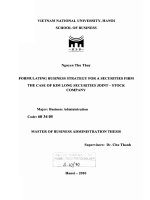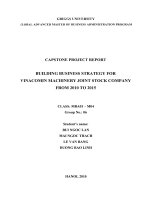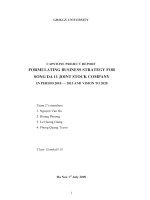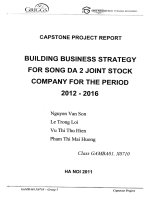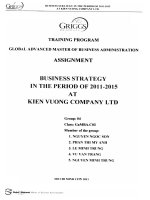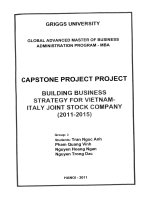Business strategy for Handee limited company, 2011 - 2015
Bạn đang xem bản rút gọn của tài liệu. Xem và tải ngay bản đầy đủ của tài liệu tại đây (2.04 MB, 103 trang )
CAPSTONE PROJECT REPORT
BUSINESS STRATEGY FOR
HANDEE LIMITED COMPANY, 2011 - 2015
Group No.: 11
LE THAI BINH
NGUYEN THIEU HUONG
NGUYEN HAI NGUYEN
DAO XUAN THO
Class: GaMBA01.C0310
Ho Chi Minh City, 2012
GRIGGS UNIVERSITY
GLOBAL ADVANCED MASTER OF BUSINESS ADMINISTRATION
PROGRAM
CAPSTONE PROJECT REPORT
BUSINESS STRATEGY FOR
HANDEE LIMITED COMPANY, 2011 - 2015
GROUP No.: 11
LE THAI BINH
NGUYEN THIEU HUONG
NGUYEN HAI NGUYEN
DAO XUAN THO
Ho Chi Minh City - 2012
BUSINESS STRATEGY FOR HANDEE CO., LTD, 2011-2015
CAPSTONE PROJECT REPORT GROUP 11
UNDERTAKING
The author group with 04 members hereby undertake that the Graduation Thesis for
the program of Master of Business Administration by GRIGGS University is the
researching work by our Group.
We have conducted theory and related data in the Thesis and partly referred from the
sources such as textbooks, curriculums, references in Vietnamese and English, as well
as from magazines, internet the practical data collected directly in Handee Limited
Company, the data of opponent companies are referred from announcements
uploading on their websites such as: Nike Golf, Adidas Golf Company, Nguyen Tam
fashion (Foci), etc…
From these sources of document and basing on the outline approved, the author group
has completed this Thesis. The solutions of business strategy for Handee Co., Ltd are
set forth dependently on literature review as well as intuition and experiences from all
members of the Group. Also through this Thesis, all members of the author group have
accumulated highly evaluable experiences to establish a practical strategy for a
company currently and in the future.
BUSINESS STRATEGY FOR HANDEE CO., LTD, 2011-2015
CAPSTONE PROJECT REPORT GROUP 11
THANKS
On the occasion of Graduation Thesis for the training program of Global Advanced
Master of Business Administration - Griggs University has been completed after one
and a half years of study, the author group sincerely thanks MBA program - GRIGGS
University and Handee Limited Company for facilitating us during studying process.
We are grateful to the Teachers who have wholeheartedly taught and imparted the very
precious knowledge to us. Also we are thankful to the Teachers who have conducted
the author group until completion of this Thesis.
Additionally, the author group would like to express our gratitude to assistant
professors who have given us the kindly supports. Thanks a lot to the leadership of
Handee Limited Company for the high evaluable data and information for this Thesis.
Finally, the author group sincerely thanks the Director Boards of the Companies those
we are working with and all family members of the author group for creating
conditions and times as well as finance so that we can complete this course.
Please receive from us the deep and sincere thanks.
The author group
BUSINESS STRATEGY FOR HANDEE CO., LTD, 2011-2015
CAPSTONE PROJECT REPORT GROUP 11
CONTENTS
FOREWORDS 1
1. THE REASONS FOR CHOOSING THE THEME 1
2. OBJECTIVE OF RESEARCH 1
3. SCOPE OF RESEARCH 1
4. METHOD OF RESEARCH 2
5. THE PRACTICAL AND SCIENTIFIC MEANINGS OF THE THEME. 2
6. STRUCTURE OF THESIS 2
Chapter I: LITERATURE REVIEW 3
1. CONCEPT OF STRATEGY AND STRATEGIC PLANNING 3
1.1. Concept of strategy 3
1.2. Strategic management 3
2. CLASSIFICATION OF BUSINESS STRATEGY 3
2.1. Levels of strategy 4
2.2. Types of strategies 4
2.2.1. Corporate-level strategy 4
2.2.2. Unit-level business strategy 5
2.2.3. Functional strategy 5
3. PROCESS OF STRATEGIC MANAGEMENT 5
3.1. Process of business strategy planning 7
3.2. Analysis of environment 7
BUSINESS STRATEGY FOR HANDEE CO., LTD, 2011-2015
CAPSTONE PROJECT REPORT GROUP 11
3.2.1. Analysis of external environment 7
3.2.2. Analysis of internal environment 8
3.3. Establishment of business strategy 8
3.4. Solutions for performing business strategy 9
3.5. Evaluating the efficiency of business strategy 9
3.6. Some tools used to evaluate and propose the business strategies 10
3.6.1. External factor evaluation - EFE 10
3.6.2. Internal factor evaluation - IFE 11
3.6.3.Competitive picture matrix (CPM) 12
3.6.4. SWOT matrix 12
3.6.5. Internal - External matrix (IE) 13
3.6.6. Quantitative strategic planning matrix (QSPM) 14
3.6.7. Some experiences for selecting the business strategy 16
4. TREND OF VIETNAM GOLF SPORT DEVELOPMENT 16
4.1. Trend of golf-court and golfer development 16
4.2. Some contents of current development of Vietnam golf market 17
CONCLUSION OF CHAPTER I…. 20
CHAPTER II: ANALYZING THE OPERATION REALITY OF HANDEE
CO., LTD. 21
1. INTRODUCTION ABOUT HANDEE CO., LTD. 21
1.1. Summary of Handee’s formation and development process 21
1.2. Company’s organizational and managerial diagram 23
1.3. Current clients and partners 25
1.4. Business and production outcomes 25
1.4.1. Working area and main products 25
BUSINESS STRATEGY FOR HANDEE CO., LTD, 2011-2015
CAPSTONE PROJECT REPORT GROUP 11
1.4.2. Revenues of Handee Co., Ltd through the years 26
2. EXTERNAL ENVIRONMENT 27
2.1. Analysis of macro environment 27
2.1.1. Impact of economic factor 27
2.1.2. Impact of political factor, policy and law 29
2.1.3. Impact of socio - cultural and population factors. 29
2.1.4. Impact of natural factor 29
2.1.5. Impact of technical and technological factors. 30
2.2. Analysis of micro environment 31
2.2.1. Potential competitors 31
2.2.2. Substitute products 32
2.2.3. Customers 33
2.2.4. Suppliers 34
2.2.5. Competitors within internal trade 35
2.3. Analysis of internal situation of Handee Co., Ltd. 37
2.3.1. Financial ability 37
2.3.2. Management of human resources 42
2.3.3. Marketing 44
2.3.4. Product quality 45
2.3.5. Procedure of production and operation 45
2.3.6. Research and development (R&D) 46
2.3.7. Core competitive advantage 48
3- OPTIONAL TOOLS FOR THE COMPANY’S BUSINESS STRATEGY 49
3.1. External factor evaluation matrix (EFE) 49
BUSINESS STRATEGY FOR HANDEE CO., LTD, 2011-2015
CAPSTONE PROJECT REPORT GROUP 11
3.2. Internal factor evaluation matrix (IFE) 50
3.3. Competitive Picture Matrix (CPM) 51
3.4. Internal - External factors matrix (IE) 53
3.5. SWOT matrix 54
3.6. Quantitative strategic planning matrix (QSPM) 57
CONCLUSION OF CHAPTER II 60
CHAPTER III: BUILDING BUSINESS STRATEGY FOR
HANDEE CO., LTD UNTIL 2015 61
1. THE GROUNDS FOR BUILDING THE STRATEGY 61
2. PREDICTION OF MARKET DEMAND 61
2.1. Demand of Vietnam golf market development 62
2.2. Predicting the revenue from golf garment products of Handee Co., Ltd
from now to 2015 62
3. THE OBJECTIVE OF HANDEE CO., LTD UNTIL 2015 65
4. BUSINESS STRATEGY FOR HANDEE CO., LTD FROM NOW TO 2015 68
4.1. Concentrated growth strategy towards market development 68
4.2. Concentrated growth strategy towards market penetration 69
4.3. Concentrated growth strategy towards product development
71
4.4. Selection of strategy 72
5. SOME SOLUTIONS FOR BUSINESS STRATEGY OF HANDEE CO., LTD. ….73
5.1. Solutions for human resources 73
5.1.1. Human resource management 73
5.1.2. Administrative organization 75
5.2. Solutions for marketing 75
5.2.1. Building the strategy for products 76
BUSINESS STRATEGY FOR HANDEE CO., LTD, 2011-2015
CAPSTONE PROJECT REPORT GROUP 11
5.2.2. Solutions for products 77
5.3. Solutions for finance 78
5.4. Solutions for building and developing trademark 79
5.5. Solutions for production 81
5.5.1. Solutions for materials 81
5.5.2. Solutions for production 81
5.5.3. Solutions for information management 82
5.6. Solutions for building the company’s culture 83
6. SOME RECOMMENDATIONS 86
6.1. Recommendations to the internal garment industry of golf products
(Vinatex) 86
6.2. Recommendations to the State 86
CONCLUSION OF CHAPTER III 87
CONCLUSION 88
REFERENCES 89
BUSINESS STRATEGY FOR HANDEE CO., LTD, 2011-2015
CAPSTONE PROJECT REPORT GROUP 11
1
CONTENTS OF FIGURES
Figure I.1: Model of comprehensive strategic management 6
Figure I.2: Process of strategic planning 7
Figure I.3: Chart of micro environment (Michael Porter)
8
Figure I.4: External factor matrix 10
Figure I.5: Internal factor matrix 11
Figure I.6: Competitive picture matrix (CPM) 12
Figure I.7: SWOT matrix 13
Figure I.8: Internal - external matrix (IE) 14
Figure I.9: QSPM matrix 15
BUSINESS STRATEGY FOR HANDEE CO., LTD, 2011-2015
CAPSTONE PROJECT REPORT GROUP 11
2
CONTENTS OF TABLES
Figure II.1: Some logo images of Handee Co., Ltd through the years 22
Figure II.2: Organizational diagram of Handee Co., Ltd. 23
Table II.3: Clients and partners of Handee Co., Ltd. 25
Table II.4: Revenue statistics of Handee Co., Ltd through the years 26
Table II.5: Chart of Handee's revenue growth from 2007 to 2011 26
Table II.6: Speed of growth and inflation through the years 27
Table II.7: Chart of Vietnam's growth and inflation speed from 2007 to 2011 28
Table II.8: Business and production outcomes statement of Handee Co., Ltd in
three years from 2007 to 2011 38
Table II.9: Employees disposition in accordance with functional departments of
Handee Co., Ltd. 42
Table II.10: Analyzing the particulars and advantages of golf products of Handee
Co., Ltd. 46
Table II.11: External factor evaluation matrix (EFE) of Handee Co., Ltd. 49
Table II.12: Internal factor evaluation matrix (IFE) of Handee Co., Ltd 50
Table II.13: Competitive picture matrix 51
Table II.14 : Internal - external matrix of Handee Co., Ltd. 54
Table II.15 : SWOT matrix of Handee Co., Ltd. 54
BUSINESS STRATEGY FOR HANDEE CO., LTD, 2011-2015
CAPSTONE PROJECT REPORT GROUP 11
3
Table II.16: Quantitative strategic planning matrix (QSPM) 58
Table
III.1: Revenues from golf garment products of Handee Co., Ltd in recent
four years
62
Table III.2: Chart of Handee's revenue growth from 2007 to 2011 63
Table
III.3: Establishing the predicted revenue equation for Handee Co., Ltd
until 2015
63
Table
III.4: Predicting the revenues of Handee Co., Ltd until 2015
64
Table III.5: Chart of Handee Golf's revenue growth prediction from 2012
to 2015 65
Table
III.6: Prediction of business and production outcomes of Handee Co., Ltd
from 2012 to 2015.
65
Figure III.7: Model for building marketing strategy of Handee Co., Ltd until
2011… 76
BUSINESS STRATEGY FOR HANDEE CO., LTD, 2011-2015
CAPSTONE PROJECT REPORT GROUP 11
1
FOREWORDS
1. THE REASONS FOR CHOOSING THE THEME
In terms of economic integration in the region and the world currently, Vietnam has
gradually affirmed the market economy under socialist orientation. Facing with the
business environment which is always fierce competition today, every business
needs to find a suitable direction, continuously improves the business position in the
market place.
Along with the growth of national economy, Handee Co., Ltd. has achieved many
successes, contributed little to the garment industry of HoChiMinh City in particular
and the country generally in the new development direction. However, over the
years, with the impact of the global economic downturn, the business environment
poses more challenges. If just relying on the advantages and business experience as
before, Handee will not be viable and continue to grow. Wishing to contribute in
finding a way for maintaining Handee’s position in the future, and applying the
knowledge learned in MSc programs, we chose the research topic of "Business
strategy for Handee Limited Company, 2011-2015” for our Economic Master
Thesis.
2. OBJECTIVE OF RESEARCH
Basing on analysis of the micro and macro environments, as well as the company’s
production and business operation status, Handee can find the appropriate business
strategy for maintaining its position and constantly growing, becomes one of the
leading prestigious enterprises in Vietnam Golf garment industry in the future.
3. SCOPE OF RESEARCH
Space of research: Garment market, in which, focusing on study of
garment market for Golf products in HoChiMinh City and other
provinces nationwide.
Time of research: The topic focuses on researching the production and
business status of Handee Co., Ltd in 2011- 2012.
BUSINESS STRATEGY FOR HANDEE CO., LTD, 2011-2015
CAPSTONE PROJECT REPORT GROUP 11
2
4. METHOD OF RESEARCH
We use the following methods for our topic: Description method, data collection,
integration to analyze the production and business status of Handee Co., Ltd.
5. THE PRACTICAL AND SCIENTIFIC MEANINGS OF THE THEME.
Scientific meaning:
In market economy, business strategy crucially decides the success and
failure of the enterprise. For survival and development, at the first time,
the enterprise should have a good business strategy and performs it.
There are many approaches to build a business strategy for an enterprise.
The research contains a scientifically theoretic significance gathered from
various sources for a business strategy formation on the basis easy to
understand, easy to use.
Practical significance:
Handee Co., Ltd. has 100% private capital. Therefore, we will analyze to
identify the strengths and weaknesses, the core competences forming
competitive advantage of the company, the opportunities and challenges
currently as well as in the future which help the company’s leaders to
develop strategies directly.
The thesis will provide Handee Co., Ltd with the quantification of
influence level of the factors that has impacted on the business.
6. STRUCTURE OF THESIS
Apart from the opening, conclusion and appendices, the thesis structure consists
of three chapters:
Chapter1: Literature review.
Chapter 2: Analyzing the real status of production and business operation of
Handee Co., Ltd.
Chapter 3: Building the business strategy for Handee Co., Ltd from 2011 to 2015.
Because of limitation of knowledge, condition and ability, our thesis is inevitable
shortcomings, Group 11 looks forward to receiving comments and suggestions from
the Teachers and Defense Council so that the thesis will be more perfect.
BUSINESS STRATEGY FOR HANDEE CO., LTD, 2011-2015
CAPSTONE PROJECT REPORT GROUP 11
3
Chapter I: LITERATURE REVIEW
1. CONCEPT OF STRATEGY AND STRATEGIC PLANNING
1.1. Concept of strategy
The concept of strategy has appeared for very long time, it originated from
military field. Nowadays, there are many various concepts of strategy:
According to Fred R. David, “strategy is the mean to achieve the long-
term goals”.
As Haroid Kooniz and the authors in their work "The core issues in
management”, strategy is an action plan to aim at achieving the specific
goals. The main strategies of an organization contain the goals and
commitments of resources to achieve these goals and the essential policies
to be followed while using these resources.
For Alfred Chandler, "business strategy involves the determination of basic
long-term objectives of the enterprise, and chooses the way or course of
action and allocates the resources to implement that goal”.
According to the definition of Dr. Nguyen Thi Lien Diep, "strategy is the
overall action plan towards the implementation of objective set up. The
strategy is not to specifically point out how can achieve the objective
because it is the duty of a multitude of assistance programs, other functional
strategies. Strategy just creates a framework to guide thinking and action”.
1.2. Strategic management
Strategic management is the process of studying the environment currently
as well as in the future. It plans the goals of the organization, puts forward,
organizes, implements and supervises the implementation of decisions to
achieve those goals in the current environment and in the future.
2. CLASSIFICATION OF BUSINESS STRATEGY
There are many different strategies in an enterprise, depending on the level, the
approach we can classify business strategy as follows:
BUSINESS STRATEGY FOR HANDEE CO., LTD, 2011-2015
CAPSTONE PROJECT REPORT GROUP 11
4
2.1. The level of strategy
In view of the levels, an enterprise has at least three levels of business strategies:
Corporate-level strategy: Strategy towards the purpose and overall scope of
the organization.
Unit-level business strategy: Relating to the successful competition manner
on the specific markets.
Functional strategy (or operational strategy): It is the strategy which helps
unit-level and corporate-level strategies to implement effectively by the
components in terms of resources, the human process and the necessary
skills.
In the globalized environment of fierce competition, the borders between the
countries have been largely eliminated so that a four-level strategy has appeared. It
is global strategy.
2.2. Types of strategies
2.2.1. Corporate-level strategy
Corporate-level strategy usually towards a basic long-term goal, there are many
strategies at corporate level with various names. According to Fred R. David, there
are fourteen types of basic corporate-level strategies which are divided into four
groups as follows:
Strategic integration group
Forward integration
Backward integration
Horizontal integration
Intensive group
Market Penetration
Market Development
Product Development
Concentric Diversification
Horizontal Diversification
Conglomerate Diversification
BUSINESS STRATEGY FOR HANDEE CO., LTD, 2011-2015
CAPSTONE PROJECT REPORT GROUP 11
5
Other group
Joint Venture
Retrenchment
Divestiture
Liquidation
Mixed strategy
2.2.2. Unit-level business strategy
Unit-level business strategy relates to the successful competition manner in the
specific markets.
As for Michael E. Porter, there are three general competitive strategies at business unit
level:
Cost leading strategy (low price and best price)
Product differentiation strategy
Gathering strategy
2.2.3. Functional strategy
Functional strategy is the strategy of functional departments such as: marketing,
finance, human resources, etc These strategies help raising the company’s
operation efficiency and assist the business strategy, corporate-level strategy to
implement effectively.
3. PROCESS OF STRATEGIC MANAGEMENT
Process of strategic management consists of three phases:
Strategic planning phase
Strategic performance phase
Strategic assessing phase
Fred R. David has made the model of comprehensive strategic management as
Figure 1, therein, the strategic planning phase includes the steps of defining vision,
mission, strategic objectives, then carrying out analysis of the external environment
factor to identify opportunities and risks, analysis of internal environment to put
forward the strengths and weaknesses of the business, from which to determine the
BUSINESS STRATEGY FOR HANDEE CO., LTD, 2011-2015
CAPSTONE PROJECT REPORT GROUP 11
6
business objectives, establish the long-term objectives and select the strategies for
implementation. Strategic performance phase will include the distribution of
resources to make the annual goals and policies. The last stage is measure and
evaluation of the strategy implementation.
Figure I.1: Model of comprehensive strategic management
ơ
Distribute
the
resources
Redefine
business
objective
Analyze internal
environment.
Identify the
strength and
weakness
ơ
Select the
strategies
for
implemen-
tation
ơ
Set forth
the
policies
Strategic planning Strategic performance Evaluation
Vision,
mission,
strategic
objective
Analyze external
environment,
identify
opportunity
and risk
Measure
and evaluate
the
performance
of strategy
ơ
Establish
long-term
objective
ơ
Establish
annual
objective
BUSINESS STRATEGY FOR HANDEE CO., LTD, 2011-2015
CAPSTONE PROJECT REPORT GROUP 11
7
3.1. Process of business strategy planning
According to Fred R. David, the process of business strategy planning consists of
three phases: input phase, integration phase and decisive phase as figure I.2:
Figure I.2: Process of strategic planning
Phase 1: Input phase
Matrix of external
factors evaluation
(EFE)
Competitive picture matrix
(CPM)
Matrix of internal
factors evaluation (IFE)
Phase 2: Integration phase
Matrix of strength,
weakness,
opportunity and
threat
(SWOT)
Matrix of
strategic position
and action
evaluation
(SPACE)
Matrix of
Boston
consulting
group (BCG)
Internal-
external
matrix
(IE)
Matrix of
main
strategy
Phase 3: Decisive phase
Quantitative strategic planning matrix (QSPM)
3.2. Analysis of environment
The enterprise’s operational environment includes the internal and external
environments, it affects directly or indirectly to the existence and development of
enterprise. Thus, studying the internal environment and external environment is
extremely necessary in strategic planning for the enterprise.
3.2.1. Analysis of external environment
Analysis of macro environment:
Analyzing the external environment helps us to identify the opportunities and risks
from which the enterprise will make a relevant strategy. Analyzing the external
environment through the environments:
Economic environment.
Governmental, politic and law environment.
BUSINESS STRATEGY FOR HANDEE CO., LTD, 2011-2015
CAPSTONE PROJECT REPORT GROUP 11
8
Technical - technological environment.
Cultural - social Environment.
Population environment.
Analysis of micro environment: Michael E. Porter, a professor of business
strategy from Harvard has given a five-force model of competition as the
following figure I.3:
Figure I.3: Chart of micro environment (Michael Porter)
Potential
competitors
Competitors of the
same trade
Intensity of
competitors
Customers
Suppliers
Substitute
products
Price squeeze
from suppliers
Risk of market share reduced due to
new competitors
Price
squeeze
from
customers
Risk from substitute
products and services
3.2.2. Analysis of internal environment
In every company, there are always different strengths and weaknesses in business
units. The strengths and weaknesses of the internal environment with opportunities
and threats in outside and with the mission statement are the grounds for setting up
the goals and strategies of the company. The elements of the internal environment
consist of finance, management, marketing, human resources, production
management and operation.
3.3. Establishment of business strategy
Depending on the enterprise’s target, external environment and internal status, its
business strategy is set up with the following tenors:
BUSINESS STRATEGY FOR HANDEE CO., LTD, 2011-2015
CAPSTONE PROJECT REPORT GROUP 11
9
Identifying and selecting the opportunities which can help the enterprise
achieve its business target.
Selecting the target market
Selecting products, services to supply the target market.
Building a Marketing-mix strategies for the market and products, service
selected: product strategy, prices strategy, distribution strategy, promotion
strategy.
3.4. Solutions for performing business strategy
For effective implementation of business strategy which has been set up, the
enterprise should have the solutions for production management, business
management; for human resources, finance, to make the strategy. That is the
arrangement, sort of company’s resources to successfully implement the optional
business strategy, namely:
Arranging the organizational structure accordingly.
Reasonable distribution, maintenance and development of human resource.
Allocation of financial resources.
Building a model of production and operation scientifically and effectively.
3.5. Evaluating the efficiency of business strategy
The evaluation of business strategy effective or not is very important. A business
strategy is considered effective when it is consistent with the reality of the business
and socio-economic situation; it may as well take advantage of the opportunities to
achieve the objectives that the enterprise set out. The evaluation of business strategy
includes the following steps:
To review and examine the appropriateness of the business strategies before
implementation.
To assess the effects of production and business activities of the enterprise
by every implementation phase, in order to detect its flaws, defects, so that
we can adjust, modify, supplement in time.
BUSINESS STRATEGY FOR HANDEE CO., LTD, 2011-2015
CAPSTONE PROJECT REPORT GROUP 11
10
3.6. Some tools used to evaluate and propose the business strategies
For performing the strategic planning, we can apply various methods and tools of
strategic planning. This thesis only has a selection to use some tools below that we
think they are useful for the developmental strategic planning of Handee Co., Ltd.
3.6.1. External factors evaluation-EFE
The construction of external factor evaluation matrix will help us to summarize and
quantify the influence of external environmental factors to the enterprise, it affects
the enterprise’s production and business activities; including the factors such as
opportunities and challenges to the enterprise.
To build the matrix, we proceed to make a list of all the external factors that affect
the company’s operation. Assess the importance of each factor by weights; the sum
of the weights of all the elements equal to 1. The classification shows the respective
importance of those factors for success in the company’s trading.
Evaluating the importance of each factor by sorting the elements from 1 to 4,
among them, number 4 is that the company has the best response; 3 is above
average, 2 is average and 1 is the lowest. These levels are based on the company’s
efficiency of strategy.
Next is to determine the score on importance of each factor by multiplying the
important degree with the corresponding classification score. After that, sum up the
total critical scores for each variable to determine the total important scores for the
company; 4 is the highest and 1 is the lowest, and the average is 2.5 points.
If total important scores are 4, it shows that the company is taking good advantage
of external opportunities and better control or minimizes threats from the outsider to
the company. If total score is 1, it indicates that the company does not seize the
opportunities and can not reduce the threats from the external environment.
Figure I.4: External factor matrix
External
environment factors
Important degree
Classification
Important score
List of external
BUSINESS STRATEGY FOR HANDEE CO., LTD, 2011-2015
CAPSTONE PROJECT REPORT GROUP 11
11
factors
-
Total
3.6.2. Internal factors evaluation -IFE
The construction of internal factor evaluation matrix will help us to summarize and
evaluate the important strengths and weaknesses of the functional business parts. It
affects the enterprise’s production and business activities.
To build the matrix, we proceed to make a list of all the internal factors that affect
the company’s production and business activities, as defined in the internal
enterprise evaluation. Assessing the importance of each factor by weights, the sum
of the weights of all the elements is equal to 1. The classification shows the
respective importance of those factors for success in the company’s trading.
Evaluating the importance of each factory by sorting the elements from 1 to 4,
among them, number 4 is that the company has the best response; 3 is above
average, 2 is average and 1 is the lowest. These levels are based on the company’s
efficiency of strategy.
Next is to determine the score on importance of each factor by multiplying the
important degree with the corresponding classification point. After that, sum up the
total critical scores for each variable to determine the total important scores for the
company; 4 is the highest, 1 is the lowest, and the average is 2.5 points.
If total important scores are 4, it shows that the company has much strength, and
possibly overcome the weaknesses. Conversely, if the total score is 1, indicating
that the company has no strength and so many weaknesses that can not be
overcome.
Figure I.5: Internal factor matrix
Internal environment factors
Important
degree
Classification
Important
score
List of internal factors
BUSINESS STRATEGY FOR HANDEE CO., LTD, 2011-2015
CAPSTONE PROJECT REPORT GROUP 11
12
-
Total
3.6.3. Competitive picture matrix (CPM)
Building competitive picture matrix helps the company identify the competitors,
and the advantages, shortcomings so that the company will have a suitable business
strategy.
This matrix includes all the elements inside and outside of the enterprise; it has the
importance to the success of the enterprise. In the competitive picture matrix, the
competitors are also considered important and calculate the total important scores.
Then, we compare the total critical scores of these opponent companies with the
sample competitive company. Thereby, we will have more information to develop
business strategy for the company.
Figure I.6: Competitive picture matrix (CPM)
Important
degree
Sample competitive
company
Competitor 1
Competitor 2
Grade
Important
score
Grade
Important
score
Grade
Importa
nt score
List of
factors
Total
3.6.4. SWOT matrix
SWOT matrix allows us to evaluate the strengths and weaknesses of the company
and estimate the opportunities and risks of the external environment. Since then put
the factors between the environmental situation and the company’s ability together
to become the business strategies. We have the following SWOT matrix:
BUSINESS STRATEGY FOR HANDEE CO., LTD, 2011-2015
CAPSTONE PROJECT REPORT GROUP 11
13
Figure I.7: SWOT matrix
OPPORTUNITIES (O)
THREATS (T)
STRENGTHS (S)
Combine S-O
Promote the internal
strengths to utilize the
opportunities.
Combine S-T
Promote the internal
strengths to avoid the
external threats.
WEAKNESSES (W)
Combine W-O
Overcome the internal
weaknesses to utilize the
opportunities.
Combine W-T
Overcome the internal
weaknesses to avoid the
external threats.
From SWOT matrix, it will help us to form four types of strategies:
Strategy of strength - opportunity (S-O): Promote the internal strengths to
utilize the opportunities.
Strategy of weakness - opportunity (W-O): Overcome the internal
weaknesses to utilize the opportunities.
Strategy of strength - threat (S-T): Promote the internal strengths to avoid the
external threats.
Strategy of weakness - threat (W-T): Overcome the internal weaknesses to
avoid the external threats.
3.6.5. Internal - External matrix (IE)
Analysis of internal - external matrix is putting the company’s departments into the
picture with 9 cells as the following image:
IE matrix is built basing on the essential factors:
Total important scores of internal factor evaluation matrix (IFE).
Total important scores of external factor evaluation matrix (IFE).
We can read this matrix as follows:
Total scores from 1.00 to 1.99: showing the weakness
Total scores from 2.00 to 2.99: showing the average
Total scores from 3.00 to 4.00: showing the strength

